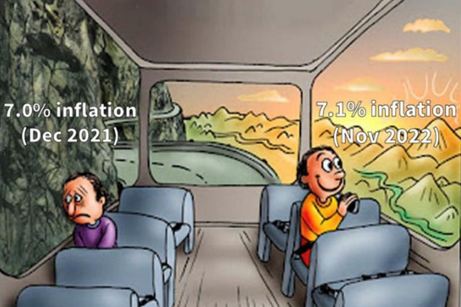
Dec 16, 2022 3:37:56 PM
Weekly Market Wrap 16/12/2022
There is no sign yet of Santa’s rally as major central banks have retained their hawkish stance and warned that further rate hikes are likely in 2023. The thought of continued rate increases by central banks is driving investor concerns that the global economy will be pushed into a recession. This week all three key central banks announced their latest policy decisions with no major surprises. However, inflation data surprised to the downside and so there is hope that the trend will continue. Recessionary signals continue to grow but not consistently, with UK and US retail sales disappointed but Eurozone business activity improved, and US jobs data pointed to a tight labour market.

UK Market
The UK market ended the week negative, despite lower than anticipated CPI figures. Inflation for November came in at 10.7%, below the 10.9% estimate. This reading provided strong support to the Bank of England’s view that inflation in the UK has now peaked after October’s 11.1% figure. The Bank of England followed the release with a 50bps rate increase as expected, taking the UK base rate to 3.50%. The Bank subsequently told investors that further increases are expected to be seen in 2023 in order to return inflation to the 2% target rate. UK retail sales unexpectedly fell in November, falling by 0.4%, when a 0.3% rise had been expected. The presence of Black Friday sales as well as the World Cup was unable to help UK retailers from experiencing a fall in sales, a clear warning sign that the UK may be on the cusp of a recession.
US Markets
The S&P 500 is currently ending the week down 2.11% at 3,851 and the NASDAQ is down 2.50% at 10,728. US CPI data surprised to the downside on Tuesday this week, with inflation for November coming in at 7.1%, below the economist consensus of 7.3%. Despite an inflation undershoot, the US market did not enjoy a significant rally as has been seen after previous low inflation figures, as investors remained cautious ahead of the Federal Reserve’s Wednesday meeting. The Fed did not surprise markets, delivering a 50bps rate increase as expected and ending a run of four consecutive 75bps hikes. Despite a reduction in the size, the Fed told markets it expects that ongoing increases will be required to ensure inflation continues to subside. Additionally, the Fed’s updated dot plot now shows a median estimate for rates at the end of 2023 of 5.1%, up from 4.6% in September. Initial jobless claims unexpectedly dropped, coming in at just 211,000, the lowest level in 5 months, whilst economists had expected the figure to be flat at 230,000. Meanwhile, US retail sales fell by more than expected in November, (-0.6% vs -0.1% est).
European Markets
The Euro Stoxx 50 is currently down 3.72% at 3,795, the DAX is 3.63% lower at 13,847 whilst the CAC 40 has fallen 3.71% to 6,430. European markets were sent lower on Thursday after ECB President Christine Lagarde reinforced the stance that central bank would continue to raise rates in future meetings, even if higher rates posed a risk to economic growth. After the ECB delivered its expected 50bps rate increase, Lagarde told investors that there are likely to be more 50bps rate hikes in the coming months and that the ECB “are not slowing down.” Investors are becoming increasingly concerned that a severe recession in the Eurozone, brought on by an extended period of higher interest rates would stunt economic growth and see company earnings suffer significantly. However, there was slight optimism on Friday as Euro Zone business activity fell by less than expected in November, offering a chance that a pending recession may be less severe than feared.
Fixed Income
Slowing rate increases and recessionary fears saw yields on the US 10-Year fell slightly this week to 3.52%. US production data fell by more than expected, hinting that the Federal Reserve’s interest rate increases may be beginning to slow the US economy.
Commodities
Brent Crude gained 3.71% this week to $79 per barrel, pushed higher by investor hopes of increased demand from China’s reopening and potential supply disruptions.
The Week Ahead
Monday –
Tuesday – China Interest Rate Decision
Wednesday – Canada CPI Data
Thursday – UK & US GDP
Friday – US Durable Goods Orders
*Price changes as of last week’s close unless stated otherwise.



